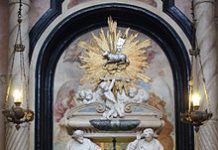One of the towns that my family frequently stays in is Alliance, Nebraska. It’s a relatively small town: population 8500. The first few times we stayed there we really hated it, but that turned out to be mainly because we were staying on the wrong side of town. Okay, technically you can still see the place we used to stay from the place we now prefer to stay, but those three blocks made a big difference in our perception of the town. Suddenly the people seemed friendlier, the town seemed less threatening, and overall we just liked it better.
Among the charms we discovered in Alliance is a stained glass shop. The shop’s owner creates gorgeous stained glass art, and also keeps a studio where anyone who walks in off the street can try their hand at glass working. I believe that this glass shop is one of my family’s favorite places to visit in all of the country. If we expect to be in town for more than a day, we usually end up making something.
The shop is an immensely fun place to work. All day long people come in and out, spending a few hours working on some project or other and offering plenty of encouragement to their fellow artists. The owner is remarkably skilled at encouraging and instructing, so that each person is able to dredge up all that hidden creativity. There are pictures and art supplies on every wall. Mistakes are expected and accidents are laughed off because apparently, one should not be too serious while working with glass. In short the shop is perfectly designed to be a place where art is born.
The glass shop is amazing and special because it is made to serve a specific purpose, and it follows that purpose without flagging. It is a place for art, and that is what it is full of. Completed art, and art-in-progress, and art-that-is-yet-to-be is everywhere.
I think that this shop is to art what a church ought to be to God. A church ought to be a place not just where God is present—since God is always present—but a place where God’s presence is abundantly obvious. A church ought to be a place where God’s presence, for lack of a better term, smacks one in the face.
In earlier times, it was very much apparent that this was very well known to the designers and builders of churches. Ancient churches are drenched in symbolism that makes it all but impossible not to recognize what the church was built for. Skeptics look with scorn on such extravagance wasted on religious beliefs, considering for anyone who believes that such extravagance was ridiculous. But there is no doubt whatsoever that those churches represented the most important thing in the lives of those who worshipped at them. This is definitely not what most churches built in the last fifty years represent.
For over a thousand years, there was no way that a church might be mistaken for something else, because a church followed basic rules that made it appear different than other buildings. But if a church is not physically separated from the rest of the world by its appearance, then is it really any wonder that they are places where people demand to be entertained. Is it so astonishing that in the absence of beautiful things to look at and think about, the most urgent thought in so many minds is the desire to escape from the week’s obligatory hour as quickly as possible.
G. K. Chesterton wrote:
[To] me it is always dreary weather, what may be called useless weather, that slings into life a sense of action and romance. On bright blue days I do not want anything to happen; the world is complete and beautiful, a thing for contemplation. I no more ask for adventures under that turquoise dome than I ask for adventures in church. But when the background of man’s life is a grey background, then, in the name of man’s sacred supremacy, I desire to paint on it in fire and gore.
In a church that is beautiful—that is among the highest works of human art—one does not have to find random thoughts to fill the time. But this also works in reverse. In a church that is bland, boring, or just not designed in a manner that compels a person to think of holy things, one’s mind is far more likely wander off to more interesting subjects. In a place that is visually appealing, or even just well tailored to its purpose, there is far less reason for one’s mind to wander. In fact, a person is compelled to seek distractions out.
One knows a grocery store just by looking at it. One recognizes a library, a restaurant, or a hospital, and then, once inside, a person focuses on exactly what the designers meant him to think about. Groceries at the store, reading or research at a library, eating at a restaurant. These buildings are designed for the sole purpose of drawing everyone’s attention to the thing that is most important at the moment. A postmodern church does not do any of that. It is a celebration not of God or the symbols and elements that draw the congregation’s attention to Him, but of the cool ways that people can design buildings. A round church may have more places for people to sit, but they rarely have as much for people to sit and think about.
A church is a place for faith to be inspired, for a person to see and feel just how important God is. The glass shop in Alliance is full of creative vibes because the people who created the shop, and the people who come into the shop put them there. A church really ought to get the same respect.











